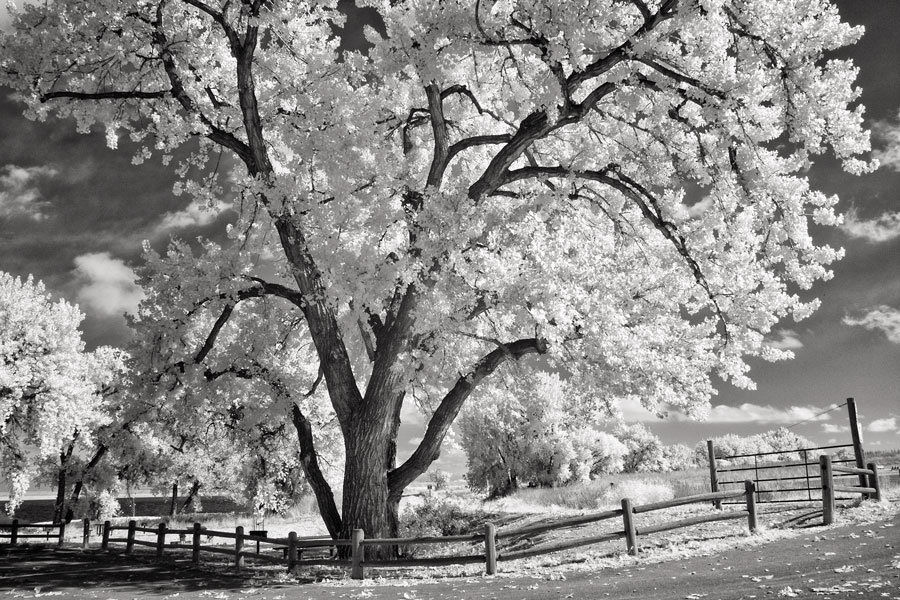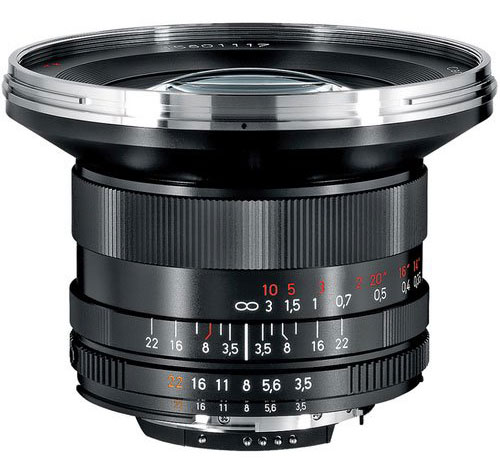Today’s Post by Joe Farace
“View life through a wide angle lens attitude and see your horizons broaden.” ―
 Over many years of shooting infrared images, whether it was using film or digital technology, I’ve gotten the best, or at least the most interesting—to me— results when shooting with wide-angle lenses. For instance…
Over many years of shooting infrared images, whether it was using film or digital technology, I’ve gotten the best, or at least the most interesting—to me— results when shooting with wide-angle lenses. For instance…
How I made this shot: The digital infrared shot at left was made at Barr Lake State Park the day before a big snowstorm was due to blow most of those leaves away. The camera used was an IR-converted Canon EOS Digital Rebel Xti with Zeiss 18mm Distagon T* f/3.5 ZF mounted and the balance of this lens on the lightweight Xti body was superb. The Digital Rebel’s 1.6x multiplication factor changes the lens’s field-of-view to the equivalent of 29mm lens but that’s just a fact of APS-sized sensor life. Exposure was 1/125 sec at f/16 and ISO 400 with a plus one-stop exposure compensation. The RAW file was converted to monochrome using Silver Efex Pro.
Distagon is a name Zeiss gives to its wide-angle lenses that use a retrofocus design. The “Dista” in Distagon is derived from the word “distance. Zeiss wide angle lenses all share the common “-gon“ ending, which is derived from the Greek word “gonia” meaning “angle.” —A Comprehensive Guide to Camera Lens Design and Zeiss Nomenclature
 Short focal lenses are typically composed of glass elements whose shapes are symmetrically placed in front of and behind the diaphragm. As the focal length decreases, the distance from the rear element to the film plane or digital sensor decreases and can even protrude into the mirror box of a DSLR requiring the camera’s mirror to be locked-up in order to use the lens. A retrofocus lens solves this problem by using an asymmetrical design allowing the rear element to be further away from the plane of focus than its effective focal length might otherwise suggest.
Short focal lenses are typically composed of glass elements whose shapes are symmetrically placed in front of and behind the diaphragm. As the focal length decreases, the distance from the rear element to the film plane or digital sensor decreases and can even protrude into the mirror box of a DSLR requiring the camera’s mirror to be locked-up in order to use the lens. A retrofocus lens solves this problem by using an asymmetrical design allowing the rear element to be further away from the plane of focus than its effective focal length might otherwise suggest.
The Distagon T* 18mm f/3.5 lens I used to make the above photograph has since been replaced in the Zeiss line-up with the sleek looking Milvus 18mm f/2.8 ZE Lens. although I prefer the traditional look off the Distagon. That original 18mm Distagon is small and light (1.12 lbs vs. 1.59 lbs for the Milvus) for its wide 90 degree angle-of-view with full-frame sensor cameras where’s it capable of delivering true wide-angle lens performance. Tip: I’ve seen used Distagon lenses on sale for as low as $765 vs. the Milvus priced at $1899, as I write this.
